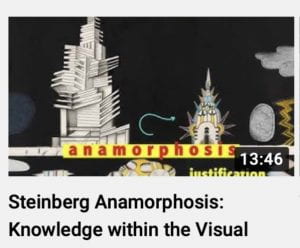 With iPSA’s reverse-zoom design (conversation first, formal sessions last), on-line materials became the critical means of avoiding on-line reproduction of the in-person conferences chief drawbacks: the limited session, rejected proposals, and parallel sessions of the traditional in-person events.
With iPSA’s reverse-zoom design (conversation first, formal sessions last), on-line materials became the critical means of avoiding on-line reproduction of the in-person conferences chief drawbacks: the limited session, rejected proposals, and parallel sessions of the traditional in-person events.
This YouTube collection includes videos on Vico’s theories about cyclopean culture, Steinberg’s alethosphere, and some crazy stuff about Lacan’s theory of metaphor, to mention a few. The list used to be chronological but in recent months has revered to putting the most recent at the top. Recent videos aspire to go beyond Lacan’s “straight” topologies to return to induction and inversion, foundational logics that grounded Lacan’s topological and visual imagination in the “knight’s move” idea of accidental encounter.
YouTube Videos
Extimacy and the Induction Puzzle of Asylum
If Lacan is correct, then the problem of asylum is structural, not just historical or social. While asylum begins as a retreat from danger, its economy can be set in reverse gear on behalf of racial purification. We can see this clearly in terms of structure, while empirical examples only muddy the waters. The matter concerns the functions and utilities of the boundary that, far from serving in the office of the wall, functions more as a Lacanian rim, a toroidal relation of subject and signifier that uses the void in ways that are ideologically undetectable but socially, ethically, and psychically catastrophic. I shall use two “pre-topological” concepts to define a new approach to the rim: (1) inversion geometry, the mathematics behind Lacan’s coined term, extimité, and (2) induction logic, present in Lacan’s thinking from Seminar I onwards. In short, this is the “defective instruction,” which is a puzzle presentation requiring reference to the rules of the game to be solved at the level of demonstration. Asylum, as refuge indistinguishable from imprisonment, requires psychoanalysis’s most serious theorizing. Without inversion and induction, we will miss the opportunity to say precisely what is going on in this age of universal estrangement. The extimité of the former and the forced choice of the latter command our attention. This speculative video moves beyond Lacan’s topology, but with the implicit support of structures that he employed from the very first years of his theory career.
The Unary Imaginary: How the Palindrome Introduces an Induction Puzzle into Psychoanalysis
This is an entirely speculative venture requiring the viewer to have some knowledge of Lacan’s Seminar XIII, especially sessions 15, 16, and 17, where Lacan borrows graphics from Girard Desargues’ “prismatic” ocular diagrams featuring a “perspective hinge” between the ground plane and picture plane. Gauss’s “palindrome solution,” the creation of a constant sum within a number series, applies to the Imaginary of the analytical session as modeled by the L-schema. The induction puzzle is a logic of self-intersection, of the frame with the framed, as in the example “There are three erors in this sentance” (the third error is the fact that there are only two errors). Lacan’s study of Logical Time uses a classic induction puzzle, the Three Prisoners’ Dilemma. The palindrome also uses induction to prove Lacan’s principle of “Ex falso, quodlibet sequitur” (Once the idea of error is revised/enlarged, anything is possible”). A follow-up video is under way to expand on the relation of the unary imaginary to topics such as anamorphosis and the gaze.
Dilation and Cathesis: A Perspective Approach to the Lacanian Induction Puzzle
Lacanian psychoanalysis is haunted by a note Freud wrote in 1938, that Psyche is extended but is unconscious of this extension. We cannot think of extension in Euclidean terms, but to follow Lacan’s thinking on the matter, we must understand his topology in terms of an underlying logic, induction and inversion, the key to the way perspective is an ETHNO-logic.. This video begins with Girard Desargues’ discovery of the perspective hinge, vision’s version of the abstract relations of symmetrical difference, chiasmus, the katagraphic cut, and even Lacan’s Borromeo model of the Real, Symbolic, and Imaginary.
In “Melancholy and Jouissance” the argument is that melancholy is a part of the oldest medical system in the world (humoristic); although the version we know comes from Empedocles, there was undoubtedly an older, shamanistic version that was based on seasonal change, not logical opposition. Video producer-designer Iraj Ghoochani has produced a narrated video of this essay. There is also a version in Farsi.
Lacan’s Inversion Circle and the Cardano Cycloid
This is a silent video that suggests a way of using Lacan’s four discourses’ sequential order and internal “lacework” to find a new “cycloid” feature. This relates to Lacan’s project of reconciling the discourses to Aristotle’s square, leading to the “extraction” of a quarter turn. Thanks to graphic designer and Lacan enthusiast Ross Sokolovsky for the graphic of the discourse wheel, which suggests a different order from the standard Master, Hysteric, University, Analysis (Analysis and University switch places). The argument is that the 4-to-3 theme that pervades Freud’s work extends to Lacan’s deployment of inversive geometry. See Jean-Michel Vappereau, “La théorie de l’identification selon Freud,” pages 63 à 83 in his Topologie en extension, 1998, Paris.
See the related position paper, Inversion of the RSI.
Lacan’s inversive Geometry: Expanded and Improved Edition
This is an enlarged and corrected edition of a silent video prepared for a zoom seminar to be held December 15, 2024. New in this edition: a way to connect Lacan’s critique of Aristotle’s logical square to the inversion circle, interior-8, and torus! Not exactly for beginners; challenging for veterans. For more information go to https://boundarylanguage.psu.edu/lacan-toronto-seminar/
Lacan’s Janusian Observer: A New Approach to Psychoanalytical (and Ethnological) Topology
This is the first part of a two-part instructional video based on the idea of the inside or Janusian Observer who is able to insert himself inside the two dimensions of topological space, where an observer is not technically allowed. This “space invader,” like the real Janus (from Roman mythology), lands in the middle of things but, because of this central point of view, must rotate to get a full view. The parallax of this interior spectator is 2x of the ordinary Euclidean observer who always looks in the same direction from a generally fixed position. The Janusian Observer, however, can see what the Euclidean observer can see only as a gap, a blank spot, or a contradiction. This is the turn converted into a cut that separates the viewer from the viewed, either on the inside of the social world of the neurotic, in the form of alienation, or from outside, as someone who, permanently or temporarily psychotic, such as Dorothy in “The Wizard of Oz,” whose magical journey amounts to a coma induced to facilitate healing. The psychotic mirroring of friends from the inside farm life of Kansas to the radical exterior of Oz, is the mystery of the mirror itself, which in Lacanian psychoanalysis is primal and primary. Part 2 will study key paintings, where non-orientation and self-intersection directly involve an embodied Janusian Observer.
Instrumental Convergence: The Fundament of Time in Psychoanalysis
This presentation for the 2024 meetings of the Association for Psychoanalysis of Culture and Society focuses on instrumental convergence as the essential topology of “the extimate,” Lacan’s idea of the inside-out.
Tiny House and Lalangue:: Video for a Zoom Discussion, June 9, 2024
This silent video highlights the importance of a diagram Lacan presents on page 53 of his essay on “lalangue” — a Brunnian variation of the Borromeo knot. Iraj Goochani has discovered that this figure is the result of a transformation of an “inverter circle” circumscribing the three rings and “extimating” the Brunnian variation according to the rules of transformation by which tangent points remain tangent, and interior circles passing through the center become straight lines.
The Timing Belt of Subjectivity
This is a fairly technical (Lacanian; topological) thesis about how we may combine three of Lacan’s “squares”: the R-Schema, the L-Schema, and the Fundamental Polygon of the Torus. Bone up on these diagrams using Lacan’s Seminars II (the L-schema), “On a Question Prior to Any Possible Treatment of Psychosis” (1959, included in the Écrits), or XIV for the fundamental polygon of the torus. You won’t get much help in the video. What justifies these overlays is the idea of a space of rotation, where a vector, to return to its origins, must complete a 4π circuit that reinters the sphere at the precise moment it seems to leave it. Next trip? On the the formula for metaphor to see what can be done there! Narrated by AI Revoicer, James.
Understanding Lacan’s Objet-a as Non-Orientation
This is a sketch of a non-mathematical approach to instrumental convergence, presupposing that it is possible to map what is otherwise unobservable. The 1951 Hitchcock film, “Strangers on a Train,” shows out the 2π realm of the tennis pro Guy Haines can be set into non-orientation by the objet-a, the monogrammed cigarette lighter stolen by the blackmailer Bruno, to force Guy into a symmetrical exchange to remove the element of motive (cf. intentionality) from the murder equation. The viewer is expected to do some homework on this!
Quantum Ethnology: from Dirac’s 1/2-spin Electron to the Pivot of the Four Quarters
This study video requires a bit of background that the viewer will have to Google elsewhere: (1) Paul Dirac’s “belt-twist trick” to demonstrate the 1/2 spin of the electron, (2) Giambattista Vico’s thesis about the localization of the first humans, (3) some working definition of the “real projective plane” in relation to projective topology. Good luck in any event … the thesis is that ethnology can be an alternative to a full mathematical understanding of such things as the space of rotation, projective geometry, and quantum mechanics, IF YOU KNOW WHAT TO LOOK FOR.
What is a zairja and how do you use it? This video serves as an “operator’s manual” for a 7000-year-old computer that, unlike the modern computer, combines chance and necessity into a composite AI model that employs the user’s own neural network to invent and explore new meanings. The Lalangue/Tiny-House Project requires participants to have at least one encounter with the zairja before joining any of the zoom seminars to develop original written essays on the connection of the (psychoanalytical) concept of LALANGUE (Jacques Lacan’s coined term to talk about language after you subtract the words) to the architectural phenomenon of the Tiny House.
The Topological Ethnology of the Tempietto
This study of the tempietto type, in terms of the “polythetic set” and topology, is about the flow of forces in culture that create laminations of ideas, uses, and forms. This video was made for a presentation to the PhD Seminar at the Washington-Alexandria Architecture Center on January 19, 2024, at the invitation of Prof. Dr. Paul Emmons and help of Camila Mancilla Vera (ABD). Thanks to Claudio Sgarbi for bringing the case of the shrine of Vaginatus to my attention.
Meninas Magic: understanding Lacan’s Seminar XIII,through Diego Velázquez’s Las Meninas (silent video)
Lacan’s session 16, Seminar XIII (The Object of Psychoanalysis) is crammed with images taken from the perspective technical drawing of Girard Desargues (left), which Lacan interprets through the projectivity of conics (right). There is much to learn here, but the diagrams are richly labeled and the commentary is complex and complicated. This video attempts to condense the logic of projective geometry into the single example of Diego Velázquez’s painting, Las Meninas, to show the fundamental logic of projectivity and the importance of distinguishing the “laminar flow” of optical and ocular lines, linked by a “strut of vision” — as “a material ligature between subject and object that supports the act of spectatorship as such” (Anthony Ballas, “Film Theory after Copjec,” Canadian Review of American Studies, 2021).
Lacan’s Seminar XIII (Object of Psychoanalysis), sessions 2–3
These silent images set up a study of Seminar XIII in terms of circuit flows and the function of viscosity by following Lacan’s contrast of optical lines with ocular ones. This video will be developed, hopefully, into a narrated video extended this idea to the remainder of this topology-intense seminar. See also the presentation of Xavier Audouard.
LACAN: Seminar XIII, Session 4
In this important session in Seminar XIII, André Green compares the R-Schema with the L-Schema, highlighting the relationship to projective geometry, the circuitry of the death drive, and to the conservation of energy flows that the neurotic subject strives to maintain in the effort to recover the lost pleasures of the pre-subject.
Precendents: The Department Store
I had thought to give a negative critique of the use of precedents in architecture teaching, but I decided that the problem with models is that they are not well understood. What better way to introduce the idea of (Freudian-Lacanian) parapraxis, with its foundational relation to metaphor, metonymy, and the psyche as a whole, than the Department Store, that grand 20c. space that taught us how to desire?
Reinterpreting Lacan’s Gaze Diagram: Reading XIII, 18
This video requires some background in Jacques Lacan’s theories. It reviews the first two graphics of Seminar XIII, “The Object of Psychoanalysis,” to show how Lacan’s objections to the intervention of Xavier Audouard, a former patient of Lacan’s, focused on Audouard’s mistaken (?) labelling of the famous graph of the gaze that Lacan had presented in Seminar XI. To access a “graphically restored” version of the translation of Cormac Gallagher, go to https://bpb-us-e1.wpmucdn.com/sites.psu.edu/dist/9/19778/files/2023/03/XIII-session-18-may18.pdf
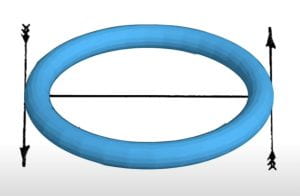 Lacan’s Topology: Turning Saussure Upside-Down and Inside-Out
Lacan’s Topology: Turning Saussure Upside-Down and Inside-Out
This silent video invites viewers to add their own captions, which might require reading (at least) the middle sessions of one of Lacan’s “middle seminars,” XIV, “The Logic of Phantasy,” available only in English translation of Cormac Gallagher. Lacan is not vague: he says explicitly the sexual “non-relationship” is a matter of … TOPOLOGY. Who are we to say otherwise? But, what is the topology he refers to? It is projective topology, where non-orientation and self-intersection involve an inversion of perspectival space and, thus, a second kind of parallax. This is not abstract, but, thanks to these two parallax properties, are foundational to the first cultures, where such phenomena as the pomœrium of the ancient city could be said to embody the torus’s projective rules about relating two kinds of voids. This geometry-in-practice was not formalized until Pappus of Alexandria in 300 c.e., then revived by Girard Desargues in the 17th Century, then forgotten again until the 19th Century, when it became synonymous with geometry as a whole for almost a century. This video is cryptic to say the least, but the aim is to show, as Lacan did in Seminar VII (“The Ethics of Psychoanalysis”) with the example of the story of Apollo and Daphne, that projective geometry is fundamental to human thought, and particularly evident when that thought is grounded in the logic of metaphor.
The Ames Window Illusion: A Lesson in Projective Topology
The Ames window is a trapezoidal flat shape that, when rotated, produces the illusion of the window moving back and forth rather than in 360º. This is especially weird if an object is placed running through one of the window panes at a right angle. The principle here is about orthogonality and isomerics/isonomics, originally terms associated with the “balancing act” of the four humors, which worked for the sanguine, phlegmatic, and choleric humors but not melancholy, because Black Bile was considered to be harmful in any amount. This has led melancholy as a diagnosis, ever since the ancients, to be the basis both of genius and prophecy, diabolical cunning and suicidal depression. Understanding the Ames window shows how non-orientation and self-intersection can work at the level of comedy, evident in the way that Charlie Chaplin’s chase scene in “The Circus” juxtaposes a linear idea of distance with a circular and oscillating one (between the Tramp’s near or far distance from the policeman). Fort/Da anyone? Apologies for my IT friend’s voice, the Etonian James, with a bit of trouble with foreign words and emphasis.
The Hamiltonian Topology of Jacques Lacan
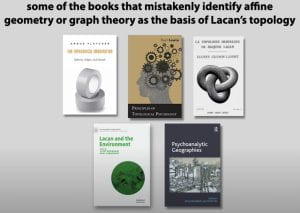 This video is prepared for presentation at LACK, a scholarly conference sponsored by the University of Vermont, Burlington, Vermont. The AI voice-over (“James,” a posh Brit) is being employed for the first time to create an “acousmatic” dimension, although he’s not so good pronouncing French names. The author is yet again grateful to Mr. Alireza Moharrer, a systems and electrical engineer who lives in Oakland, California, for introducing him to idea of the Hamiltonian, although he has applied it to alien materials, hopefully in the spirit of the idea if at the expense of the letter. The Hamiltonian in this Lacanian context has come to stand for the global principle of self-intersection, which for Lacan always involves a twist, fold, or crisscross. To be experienced, the Hamiltonian must immerse into 3-space in what the author calls “Escher formations,” locales that embody the Hamiltonian with spatio-temporal anomalies.
This video is prepared for presentation at LACK, a scholarly conference sponsored by the University of Vermont, Burlington, Vermont. The AI voice-over (“James,” a posh Brit) is being employed for the first time to create an “acousmatic” dimension, although he’s not so good pronouncing French names. The author is yet again grateful to Mr. Alireza Moharrer, a systems and electrical engineer who lives in Oakland, California, for introducing him to idea of the Hamiltonian, although he has applied it to alien materials, hopefully in the spirit of the idea if at the expense of the letter. The Hamiltonian in this Lacanian context has come to stand for the global principle of self-intersection, which for Lacan always involves a twist, fold, or crisscross. To be experienced, the Hamiltonian must immerse into 3-space in what the author calls “Escher formations,” locales that embody the Hamiltonian with spatio-temporal anomalies.
Projective Geometry: A Quick View of Ethnological Potentialities
This is an 11-minute overview of the ethnological possibilities of projective geometry. First, it’s necessary to distinguish projective geometry from affine geometry’s “rubber-sheet” topology, to establish what is mathematically non-orientable and self-intersection. This presentation will be given at the conference on Architecture of Finishing, Virginia Tech., April 2023.
The ANYWHERE of Projective Geometry
Projective geometry (the topology of the real projective plane) begins with Pappus’ theorem (300 a.d.) and Girard Desargues’ adaptation of it. The projective construction of the “perfect shadow” (the invisible portion of the visible scene, whatever blocks our view) has a determinacy that is projective and anamorphic, the basis of the idea of Fate and the unconscious. As always, I owe Alireza Moharrer, again, an enormous debt of gratitude for introducing me to the Hamiltonian, to projective geometry, and to many other aspects of mathematics which, although I am barely able to understand them, have proved to be of enormous importance. Ali’s patience in trying to educate a mathematical illiterate seems infinite. Note: this video has no sound.
 Krispy Kreme: The Story of Two Parallaxes and the Depth of Desire
Krispy Kreme: The Story of Two Parallaxes and the Depth of Desire
Jacques Lacan invents a “slide-rule analogy” to explain the inner workings of the unary trait in terms of sexual difference, desire, and the structure of the two Others (the Big Other, and the small-a object/autre). Using the analogy of Krispy Kreme Doughnuts, where the idea is to have the next doughnut to taste as good as your first doughnut, even marketing executives know Lacan’s trick, of making the “je ne sais quoi” of desire and demand into an infinitely repeatable experience.
Lacan: Logic of Fantasy (Seminar XIV), Session 19
This is a review of the May 10, 1967 session of Lacan’s Fourteenth Seminar, “The Logic of Phantasy,” Lacan analyzes Edmund Bergler’s thesis on oral masochism by relating it both to his theory of metaphoric suppression and the (toroidal) logic of “humiliating refusal.”
Hamiltonian Architecture: the Global and Local of Finishing
Projective geometry is essential because it shows how things are structured, how traps become asylums and vice versa, how life stretches between the two poles of the uncanny, how the imagination grounds itself in the theme of descent, on behalf of the Hamiltonian, how there is no space without time and no time without space. The Hamiltonian inventory uses what Jacques Lacan called extimacy, the intimate exterior, which is simultaneously an alien objectivized interior. If we lose sight of this cross-inscription of the uncanny we cannot theorize the least part of our subjective world, which is already objective at the level of the detail and the slip of the tongue, the bungled explanation. The idea of finishing in architecture involves including the sum total of actions and thoughts that go into the construction, use, and eventual deterioration and ruin of buildings. To make a truly complete inventory, this also involves the experiences, thoughts, and emotional investments made in the built environment. The “atoms” of the uncanny — the living person who, fleeing death, runs directly into death’s arms; and the dead person who fails to realize they are dead — serve as models for architecture’s conditions of continence (bounded, mortal) and incontinence (unbounded, immortal). This video was developed as a presentation for the Conference on Finishing, Washington-Alexandria Architectural School of Virginia Tech, April 2023.
Villarceau Circles: Linking Lacan’s cut/bar to the Projective Form of the Torus
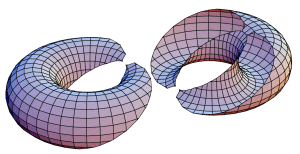 This is a silent instructional video, expressly for readers of Lacan’s Seminar XIV (The Logic of Phantasy), 1966–1967. Lacan’s extensive use of the torus’s FUNDAMENTAL POLYGON has gone almost completely unnoticed, but it has interesting implications for Lacan’s many adaptations of Aristotle’s square of logical oppositions. In particular, the “Villarceau circles” play a key role. There are four circles that may be drawn onto the torus, one “around” the torus’s ring, the other around the “tube,” and two others, orthogonal to each other, whose cuts divide the torus into parts whose chiralistic faces are Möbius bands, and whose profiles are the “vesica pisces,” commonly used in art in reference to virginal marriage. Lacan correctly designates the vesica as Euler circles, which effect a “union without intersection” (topological description of the Virgin Mary’s perpetual virginity). This video is speculative and thus both incomplete and in error, especially when the attempt is made to connect Lacan’s toroidal diagram in Seminar XIV to the L-schema. Apologies in advance! USE THE SPACE-BAR TO PAUSE THE PRESENTATION IF YOU NEED TO TAKE LONGER TO STUDY AN IMAGE OR TEXT.
This is a silent instructional video, expressly for readers of Lacan’s Seminar XIV (The Logic of Phantasy), 1966–1967. Lacan’s extensive use of the torus’s FUNDAMENTAL POLYGON has gone almost completely unnoticed, but it has interesting implications for Lacan’s many adaptations of Aristotle’s square of logical oppositions. In particular, the “Villarceau circles” play a key role. There are four circles that may be drawn onto the torus, one “around” the torus’s ring, the other around the “tube,” and two others, orthogonal to each other, whose cuts divide the torus into parts whose chiralistic faces are Möbius bands, and whose profiles are the “vesica pisces,” commonly used in art in reference to virginal marriage. Lacan correctly designates the vesica as Euler circles, which effect a “union without intersection” (topological description of the Virgin Mary’s perpetual virginity). This video is speculative and thus both incomplete and in error, especially when the attempt is made to connect Lacan’s toroidal diagram in Seminar XIV to the L-schema. Apologies in advance! USE THE SPACE-BAR TO PAUSE THE PRESENTATION IF YOU NEED TO TAKE LONGER TO STUDY AN IMAGE OR TEXT.
Lacan: Logic of Fantasy (Seminar XIV), Session 19
This is a review of the May 10, 1967 session of Lacan’s Fourteenth Seminar, “The Logic of Phantasy,” Lacan analyzes Edmund Bergler’s thesis on oral masochism by relating it both to his theory of metaphoric suppression and the (toroidal) logic of “humiliating refusal.”
Psyche Extended: The Connection of Uncanny and Anamorphosis
This silent video is an instructional introduction to the promise behind Freud’s enigmatic note, 1938, that “Psyche is extended; knows nothing of it.” The viewer will have to fill in many details. Other instructional videos on this channel may help explain key concepts sufficiently to make this work.
Prometheus: Another Way to Count the Unary Trait
In Session 18 of Lacan’s Seminar XIV (The Logic of Phantasy), focus is on the unary trait and its involvement in the (geometric/mathematical) definition of the objet petit a (little other) and Big Other, A. In the more general project of seeing ‘Psyche extended’ (Freud) as an ethnographical matter, the question becomes ‘extended INTO what?’ and ‘with what KIND of cut? This video looks at the story of Prometheus, which is about the strict sequencing rules applied to divination in ancient cultures, also applies to this modern film, My Man Godfrey (1936), where fire figures in the first and last scenes. I add Vico to Lacan to get a theory of sexual difference that is based on the unary trait, as a 1 that is both itself and not itself (‘audioactive’). The key to connecting the unary trait to theories of sexuation and discourse depend on the device of the ‘fundamental polygon’ to isolate the plus-minus conditions of the sexuation matheme, converting it into a kind of Rosetta Stone. In the resulting alignment of Lacan’s several quadration schemas, it seems possible to see Psyche extending itself with a distinguishing action that conditions, simultaneously, the material being distinguished. The historical name for such a cut (‘katagraphic’), and the name for the line of division that connects viewer and viewed (‘cathetic/cathesis’), suggests further steps to talk about transitional SPANS (cf. Freud’s essay on ‘Transience’) and the (Vichian) approach to the problem of conatus, as both stillness and motion.
Ramón Llull’s Empty Wheels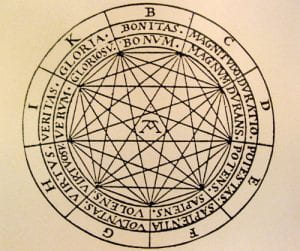
This silent video is a supplement to a zoom lecture series. Artificial memory, precursor to AI, seems at first to involve combinatorial protocols for combining known topics, but in fact the topics were (Lacanian) master signifiers, without specific content. Memory wheels, derived from mystic Christian/Arabic/Jewish zairjas (devices involving astrology calculations) generated new knowledge based on combinatorial contrasts. The thesis here focuses on the katagraphic cut function, or “consubstantiality,” the creation of a fully oppositional/antagonistic category out of simple negation or privation.
No Sex Equals Sex Everywhere
This video is for medium-advanced readers of Lacan who wonder how his mathemes of sex differentiation relate to discourses and ethnology. It presupposes some knowledge of Seminar XIV, The Logic of Phantasy. Thanks to the pioneering work of William J. Urban, the connections between sexuation, discourse, and topology point the way to metonymy’s centrality in Lacanian theory. Urban has already addressed topology and focuses on the torus as Lacan’s principal projective connector. But, it is necessary to add the cross-cap’s connection of continence and incontinence to see how metonymy and parapraxis relate broaden sexuation to cover the full range of the psychoanalytical functions of the signifier.
A New Zairja: A Camera Obscura for the Four Humors
This narrated video proposes to use the camera obscura as a paradigm for a revised reading of the theory of humors, as a potential model of Freud’s late (1938) conjecture, “Psyche is extended; knows nothing about it” (Psyche ist ausgedehnt, weiß nichts davon).
A Lacanian Twist in the Theory of the Four Humors
This is a long and somewhat draggy lecture, originally conceived for a session of the theory class directed by Prof. John Shannon Hendrix at Roger Williams University. The ancient theory of humors is the first attempt at sustainability, ambitiously connecting the microcosm and macrocosm. Its one defect lay in the way the double cut of dry/wet and cold/hot created a sequence that conflicted with the narrative order of the hero, whose birth-to-death sequence was put on pause by a timeless melancholic interval. Corrected with a twist, we discover the object-petit-a in relation to a choleric Other, the hero at a zenith solar position, Nietzsche’s noon (the shortest shadow). The dry line to the melancholic lover/poet/madman reveals both a diagnosis and semiologic schema, connecting metonymy, parapraxis, and the performative arch of suppression v. emergence.
The Idempotency of Desire
This instructional/study video looks at Freud’s graph of dream events (The Interpretation of Dreams (1899) to show how idempotency, the Vorstellungsrepräsentanz, and the unary trait create insulation of the dream that is the same stuff as the insulation of the Unconscious. This is a fill-in-the-blanks video requiring the viewer’s thoughtful infill of connective tissue, but the metaphor of dream sustenance as travel and the suppression (self-editing) of the dream as a dressing room with mixed-up costumes can possibly help.
Steinberg Anamorphosis: Knowledge within the Visual
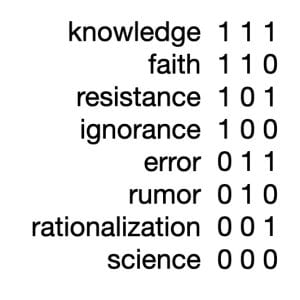 This silent video was prepared for an architecture theory class at the Technical University of Athens, November 16, 2021, directed by Prof. Riva Lava.. The argument is to connect anamorphosis, as latent visual content, to a “truth of jouissance” in the Gettier Table’s spread of options based on “justified true belief.” Thanks to Dan Collins, “A Short Digression on the Meaning of Knowledge,” Lacunæ 18 (June 2019): 70–93, for his review of the Gettier Problem and original “solution” involving deficient states of knowledge (Faith, Resistance, Ignorance, Error, Rumor, Rationalization, Science). Thanks also to Alireza Moharer of Oakland, California, for alerting me to the importance of idempotency, the “power of the same,” which figures prominently in Lacan’s thinking.
This silent video was prepared for an architecture theory class at the Technical University of Athens, November 16, 2021, directed by Prof. Riva Lava.. The argument is to connect anamorphosis, as latent visual content, to a “truth of jouissance” in the Gettier Table’s spread of options based on “justified true belief.” Thanks to Dan Collins, “A Short Digression on the Meaning of Knowledge,” Lacunæ 18 (June 2019): 70–93, for his review of the Gettier Problem and original “solution” involving deficient states of knowledge (Faith, Resistance, Ignorance, Error, Rumor, Rationalization, Science). Thanks also to Alireza Moharer of Oakland, California, for alerting me to the importance of idempotency, the “power of the same,” which figures prominently in Lacan’s thinking.
The Steinberg Alethosphere
In the 1960s, Jacques Lacan anticipated the phenomenon of gadgets connecting our locales to global networks that, in the guise of feeding our desires, would exploit us. In Saul Steinberg’s funny projections of New Yorker’s view of the world, we have the same deconstruction of the ideas of distance and contiguity that Lacan’s “alethosphere” proposed. Dan Collins has opened up the “Gettier Problem” (the inadequacy of the “justified true belief” model of knowledge) to create an in-between of latent knowledge akin to anamorphosis. In his table of conditions that relate to knowledge by failing, we can recover the idea of Lacanian jouissance at work, constructing a projective geometry of subjectivity where retroaction and the unary trait reveal a new kenosis: the unconscious.
Save the Tears for Later: The Return of Cyclopean Mind in Pandemic Times
This silent sequence argues that the first metaphoric human mentality, associated with “cyclopean” hearth-based institutions of divination and laws, has returned with lockdowns and shelter-in-place policies in Covid times. This work blends the theories of metaphor of Giambattista Vico (1668–1744) and the French psychoanalyst, Jacques Lacan; both theories involve latency and a “thaumatropic/anamorphic” function.
From the Look to the View: A Thesis in Images
This silent sequence of panels and builds argues for Lacan’s double-cone theory of the visible, where antipodal points of focus force an overlapped “screen” that serves as a fourth wall offering the subject access to the interior of the exterior (and vice versa).
Architecture of the Span (connecting metaphor to topology)
This video presentation was prepared for the conference organized by The Criptic Collaborative, “Architectures of Hiding,” coordinated by Rana Abughannam, Émélie Desrochers-Turgeon, Pallavi Swaranjali, and Federica Goffi of Carleton University’s Azrieli School of Architecture and Urbanism. A position paper details the arguments of this keynote address Architecture of the Span
The Stendhal Syndrome: Zoom Session Presentation
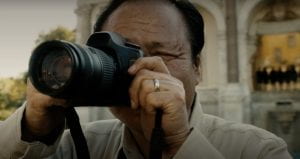
This third zoom seminar offered by iPSA (institute for psychoanalytic studies in architecture) focuses on the “Stendhal Syndrome,” the sudden collapse of patrons before the overwhelming experience of the work of art. Examples extend to architecture and the landscape, where beauty or fright breaks through the imagined “fourth wall” insulating the viewer from the viewed. For a prospectus of this event see Stendhal Syndrome Zoom Call for Papers These images connect the Stendhal to psychoanalysis via projective geometry, the dream, idempotency, anamorphosis, and the idea of locale.
The Devil’s Bridge: Introduction (in process)
Legends of artists who sell their souls to the devil in order to achieve super-human accomplishments follow a constant pattern that derives from the Greek God Pan’s aspect of a SPAN between earth and heaven, life and death. Pan was the first mortal Greek god and, on this account, compares to Adam and Eve. This is a study video in collaboration with Claudio Sgarbi, Architect, Modena, Italy.
The Structure of the Alethosphere Is the Structure of the Con
The “alethosphere” and “lathouse” were two terms coined by Lacan in his Seminar XVII, “The Other Side of Psychoanalysis.” This video puts forward a thesis that this pair of ideas was related to the ancient theme of the confidence trick, whose three terms (the Con, the Mark, and the Shill) establish a more evident bridge between our Euclidean expectations and our Projective Geometry desire. This video extends the argument of “Gadgets, Tricks, Scams, and Cons: The Virtuality of Deception,” also on the subject of Seminar XVII. For essays on the same topic, visit The Curvature of the Alethosphere , and Is Not the Alethosphere the Perfect Place to Hold a Pandemic?
Gadgets, Tricks, Scams, and Cons: The Virtuality of Deception
In Seminar XVII, “The Other Side of Psychoanalysis,” Jacques Lacan described a universal theory of the gadget that was ahead of its time in nailing how things we carry in our pockets (iPhones, etc.) make us servants of a 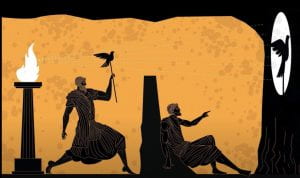 universalizing network of capitalist exploitation, data-mining, and, well, mind control, to use an old-fashioned term. This silent essay will eventually be narrated, but for now the viewer is encouraged to add an original sound track. The argument moves from a few examples to the topological structure of the cross-cap, which Lacan favored in his notoriously difficult work, L’étourdit. The aim here is not so bold as to convince but provoke, in a graphically amusing way.
universalizing network of capitalist exploitation, data-mining, and, well, mind control, to use an old-fashioned term. This silent essay will eventually be narrated, but for now the viewer is encouraged to add an original sound track. The argument moves from a few examples to the topological structure of the cross-cap, which Lacan favored in his notoriously difficult work, L’étourdit. The aim here is not so bold as to convince but provoke, in a graphically amusing way.
Does Architecture have a Psychoanalytical Imagination?
Architects can be imaginative or unimaginative, but does architecture already “have” an imaginary it can call its own? This video argues that anamorphosis, as a “passive” and temporalizing element within the normative Euclidean/Vitruvian building constitutes a secondary kind of virtuality, a virtuality of effectiveness, where time and space are indistinguishable. This is a virtuality maintained through projective surfaces such as the Möbius strip and cross-cap, where the connections to Lacanian psychoanalysis become obvious. Because the figure is “fast” in comparison to the “slow” ground, anamorphosis shows how the two meanings of fast (both quick and tightly bound) set up conditions around figure–ground reversals (as in the fixed sleeper’s experience of motion in a dream) engage an “a-temporal” temporality.
The Truth of Truth: Metaphor in the Service of the Everyday
Truth in psychoanalysis takes several specific forms. First, there is the aim of the psychoanalytic session, when analysands are able, on their own, to allow “trapped signifiers” to escape their lips. This moment is staged by the analyst, for whom the analysand’s truth must not be trespassed or divulged; instead, the “truth of analysis” is the structuring of the egos in relation to the S (Es) and dummy role of the analyst, given in the L-Schema. I see this as a “twist” circuit connecting a primary virtuality — space within which the analyst and analysand sit as egos — and a secondary virtuality that Žižek has characterized as a space serving as the Efficient Cause of truths of the Imaginary, Symbolic, and Real. This is, in effect, the “truth of truth,” a phrase dreamt by one of Lacan’s analysands in Seminar IX, on Identity.
The Gadgetry of Hitchcock: Part One: Why (Not) Lacan (for Architects)?
Lacanian psychoanalysis offers a powerful but challenging ground for research in the interpretation and creation of architecture, but the buy-in is steep, considering the volume of Lacan’s writings and teaching as well as the growing secondary literature. The clear benefit is a consistent theoretical domain focused on the subject and its cultural and historical contexts. These podcasts were produced expressly for the graduate architecture theory seminar, Washington–Alexandria Architectural Center of the Virginia Tech. University, directed by Paul Emmons. They focus on Alfred Hitchcock’s Vertigo as a key to Lacanian anamorphosis. See the accompanying text Why (Not) Lacan?
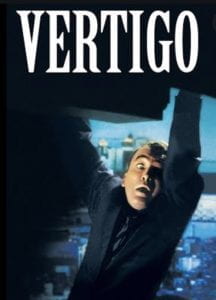 The Gadgetry of Hitchcock, Part Two: “Vertigo” and Case for Psychoanalytic Theory in Architecture
The Gadgetry of Hitchcock, Part Two: “Vertigo” and Case for Psychoanalytic Theory in Architecture
Lacanian psychoanalysis offers a powerful but challenging ground for research in the interpretation and creation of architecture, but the buy-in is steep, considering the volume of Lacan’s writings and teaching as well as the growing secondary literature. The clear benefit is a consistent theoretical domain focused on the subject and its cultural and historical contexts. This two-part podcast was produced expressly for the graduate architecture theory seminar, Washington–Alexandria Architectural Center of the Virginia Tech. University, directed by Paul Emmons. They focus on Alfred Hitchcock’s Vertigo as a key to Lacanian anamorphosis. Part Two considers story structure, the récit fort (strong narrative), the zairja, and the relation to “ars topica.”
Criticism by the Cut: An (Ersatz) Alternative to Interpretation Based on the Frame
In architecture, orthographic drawings use parallel construction lines to “bring to the surface of the paper” measurable details of a space that are equalized and transferable. Plans, elevations, and sections are like cuts into the space that subtly convert the perspective view of a single viewpoint into a “touchable” plane. This is not simply about the how to make a technical drawing, however. The orthographic method is more about an ortho-psychic relation to things that comes close to a kind of necromancy, a penetration into the imagined souls of objects and spaces. The real force of orthography is anamorphic: finding the right “angle of view” that finds a balance-point in the object, person, or scene that is able to leverage sympathetic forces. In this way “the hidden” is given a voice (apophrades) without being exposed to the light of day. For a supplementary essay, visit “Orthography: Seeing with the Eyes of the Devil.”
Orthographics to Psychographics
Todd McGowan tells an interesting story in his book on psychoanalytic film theory. It’s about Joan Copjec’s single-handed revolution, reversing 30 years of film criticism done in the name of Jacques Lacan. “No no,” said Copjec, in a single essay that showed how Michel Foucault had hijacked the idea of apparatus — dispositif in French — from Gaston Bachelard’s science writings to create the idea that the subject was completely trapped by ideology. The emblem of this entrapment was the Panopticon, a building made famous by a guard tower shielded with venetian blinds so that prisoners couldn’t tell whether guards were present or absent. Foucault claimed that the result was behavior “as if ” guards were always present, but this was not the case. Copjec called out Foucault for misrpresenting the idea of dispositif, but she left intact Foucault’s take on the Panopticon. If she had gone one step further, I claim, the Panopticon itself would have an interesting story to tell, and this is the story of the orthographic drawing, a section cut where building interiors are shown in a 1:1 scale consistent way. The Panopticon is essentially a section drawing turned into a building, with the IDEA of ortho-graphics turned into the IDEA of ortho-psychics — “self-correcting.” I want to reconnect the dots by taking the step Copjec did not take. Because section drawings are not limited to architectural drafting boards, because the idea of a section drawing can be found all over popular culture, literature, and ethnological practices, I hope to show that there is more to the Panopticon than meets the blinded eye.
Möbius: Drawing the Real
What is a Möbius band in terms of a being a circuit? Is it a 360º turn, or does the single surface make it 720º? This video uses some simple comparisons to demonstrate the Real’s relation to the idea of a circuit that must be completed with the projective geometry ideas of non-orientation and self-intersection. This introduces a series of podcasts addressing the way circuits are involved in boundary-creation, group/culture formations, dream formations, and other phenomena.
Orthography to Idempotency: Dream Paralysis and Figure-Ground Reversal
The classic drawing in architectural representation, the section, uses orthography (parallel construction lines) but it also connects to the idea of “orthopsychics,” thought’s ability to correct itself. This essay uses analogies of dream idempotency (the necessity of immobilizing the sleeper with a figure-ground reversal), the “dispositif” (self-correcting device), capitalist surplus, the forced choice, and projective geometry to define the Lacanian subject as self–intersecting and non-orienting. To connect these ideas to popular culture, the Lacanian “lathouse” and its corresponding “alethosphere” are demonstrated through the thaumatrope, a simple gadget for creating a virtual connection between two opposed images. For a text of the voice-over narrative, see The Section Idea
The Reverse-Zoom Symposium: Begin Collaboratively, End Collaboratively
This video describes a conference protocol that starts with informal zoom sessions self–managed by small groups of scholars working on common interests. The small groups invite outside critics, then formalize products (lectures or shows) that they publish on YouTube. These are the basis of a collective event where materials made available beforehand allow audiences to form questions and responses before coming to the live sessions. Sessions are managed by the small discussion groups; without having to re-run presentations in full, authors can discuss their views with a fully informed audience.
Architecture IS Authentic Travel
What is the relation between Architecture and Travel? We travel to see “good architecture,” but is there an architecture built into travel itself, that makes us able to see architecture in the context of travel, almost exclusively? If this is true what makes travel “authentic” with respect to the understanding of architecture? This summary video draws from primary documents: (1) a thesis on the use of travel as theory research, “Ersatz Travel.” and (2) Henry Johnstone, Jr.’s essay on “The Categories of Travel, at Odysseus as Traveler: A Categorial Study.” This is the final of a series of three podcasts on the relation of architecture to travel. For the script of this podcast (avoiding the overlay of closed captions), visit notes to the travel lecture. Thanks to Sadra Tehrani for his work on the “extimacy” of Central Park (Master’s Thesis, Penn State) and to Alireza Moharer, mathematician and engineer, who has patiently been teaching me about idempotency and projective geometry.
Lacan’s Metaphor Matheme, Animated
Jacques Lacan’s formula (“matheme”) for metaphor is complex. In some ways, it seems to aspire to be a mathematical expression, but unexpected substitutions and notations say otherwise. This is an experiment, and unorthodox. The wager here is that, by animating the terms of the matheme, the important functions of latency and idempotentiality (where the dream strives to paralyze the dreamer and seal off the dream from external stimulæ) can be brought to the fore. Lacan wishes to distinguish metaphorical MEANINGFULNESS from metaphor’s role in creating ordinary paradigmatic functions, i. e. “just meanings.” By doing this, Lacan aligns metaphor with the architectural void and shows how, in the uncanny in general, there are “anamorphic” elements preserving meaningfulness from endless dictionary-like substitutions and interpretations. See also the longer video podcast, “The Haunted Mirror Tale“. References in this video are to that clip, which describes a mirror that has magically embedded a traumatic scene in the 19c. (an invalid-husband’s murder of his wife) and delivered it to a modern counterpart who, standing before the mirror, sees not his bedroom but the reflection of the original murder scene. For ‘answers’ to this study guide, see Idempotency Answers.
Authentic Travel: An Ersatz Experiment
This video podcast is a study guide for “Travel as Stillness-in-Motion, a complex essay that argues the case that the true traveler effects a kind of stillness inside the travel landscape. The full paper can be found here: Ersatz Travel.
Lacan’s Matheme for Metaphor: A Revisionary View
This is a study guide, an extract of a longer presentation on the role of latency, idempotency, and figure-ground reversals. The references in the video to the “Haunted Mirror Story” relate to the 1945 British thriller, The Dead of Night. Note: this analysis substitutes a “=” for Lacan’s “→” to look at how Lacan’s intention to create a formula had exceptions to algebra that were both strategic and informative. The concluding and most unorthodox conversion turns “→” into “⇄”.
Metaphor as Uncanny Latency
Because latency is the stuff of metaphor, dreaming, and the uncanny, it shows us how to connect psychoanalysis to popular culture and the arts. Looking at Jacques Lacan’s (complicated!) matheme for the metaphor reveals it to be a function of paralysis, akin to the idempotency of the dream (to keep the dreamer dreaming). Latency uses projective geometry (“non-Euclidean”) to exploit the phantasmagoria function of dreaming for popular culture applications: folklore, ritual, the arts, architecture. Latency’s other name is “anamorphosis.” This video was prepared to present at the annual meetings of The Association for the Psychoanalysis of Culture and Society, 2020. A text of the narrative can be found at The Truth of Truth
Architecture as (Lacanian) Metaphor
The dream differs from waking reality by the need to immobilize the dreamer, by moving the ground across the figure, but the dreamer maintains the illusion of being a figure moving across a stable ground. This difference (idempotency) reveals how Lacan’s complex theory of metaphor is actually a program for architecture’s deployment of anamorphosis a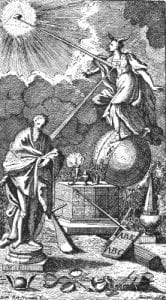 nd the uncanny — i. e. what makes architecture different from building. For a full text of the narrative, see Psychoanalysis and/of Architecture The Structure of Latency in Metaphor
nd the uncanny — i. e. what makes architecture different from building. For a full text of the narrative, see Psychoanalysis and/of Architecture The Structure of Latency in Metaphor
The Origin of Cities
This podcast on the origin of cities combines accounts from Fustel de Coulanges’ The Ancient City, Paul Wheatley’s The Pivot of the Four Quarters, and Aldo Rossi’s fable of the foundation of the Forum Romanum in his Architecture of the City. Giambattista Vico provides literary evidence of the nature of Cyclopean societies and the beginning of family religions centered around the hearth–worship of the ancestral dead. Clues about city foundation rituals come from Frazier’s The Golden Bough and other sources. See the supplemental text: The Origin of Cities.
Vico and the Case of the Latent Signifier
Giambattista Vico (1668–1744) was an original theorist working in the Naples of the Inquisition. In his major work, The New Science (1744), he discovered the foundational principle initiating human thought proper, a theory of metaphor as a framework and basis for “latency,” the strategy of concealment and secrecy essential to human institutions and communications. In some sense, Vico could legitimately have claimed to have invented the idea of the unconscious, some 200 years before Freud. Supplementary text: Vico’s Science of Metaphor